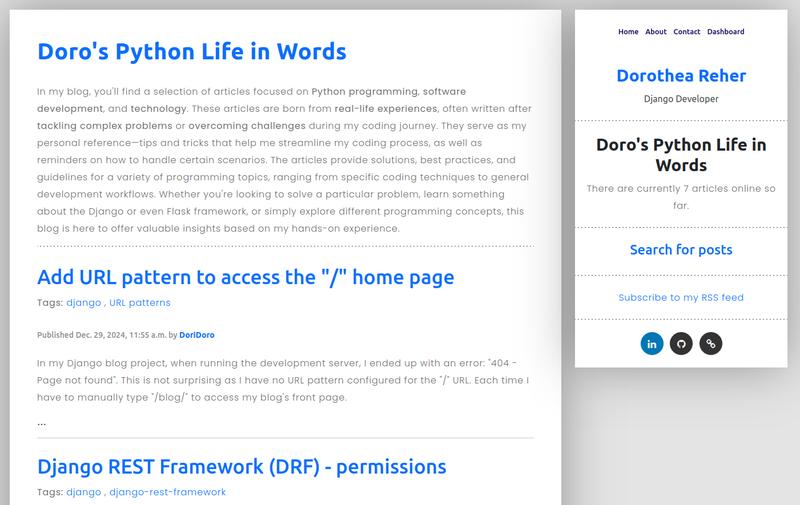Project information
- GitHub URL: Django Blog Application – Doro's Python Life in Words
- create date: Oct. 7, 2024
- Skills:
Python
Django
Git
GitHub
Branching
SQLite
Flake8
PEP8
HTML5
CSS3
Makefile
Bootstrap
Introduction
This Django blog project: Doro's Python Life in Words focused on developing a feature-rich blogging platform with a strong emphasis on performance, modularity, and best practices. The project integrated advanced search functionality, SEO optimization, and a seamless user experience. It involved the use of PostgreSQL for a scalable database solution, containerization with Docker, and innovative features such as custom template tags and content tagging.
Project Highlights:
-
- Advanced Query Handling: Designed and implemented custom model managers for efficient and powerful database queries.
- Metadata Optimization: Leveraged Django's Metadata options to enhance model functionality and performance.
- Enhanced Admin Panel: Extended the admin interface with advanced features for better usability and content management.
- Canonical URLs: Utilized the
get_absolute_urlmethod to create SEO-friendly canonical URLs for blog posts. - Search Engine Optimization (SEO): Implemented effective SEO strategies to enhance the visibility of blog posts.
- Pagination: Integrated pagination to manage and optimize the display of large datasets.
- Class-Based Views (CBVs): Used CBVs for modular, reusable, and efficient backend design.
- Email Functionality: Configured Django’s email framework to enable email notifications and content sharing.
- Post Sharing via Email: Developed Django forms to allow users to share blog posts via email.
- Commenting System: Built a robust commenting system using forms generated from models.
- Tagging System: Implemented tagging functionality with
django-taggitto categorize and organize posts. - Similar Post Retrieval: Designed logic to retrieve posts similar to a given one based on tags.
- Dynamic Template Features: Created custom template tags and filters to display dynamic content, such as latest posts and most-commented posts.
- Sitemap Integration: Added a sitemap to the blog for improved search engine indexing.
- RSS Feeds: Developed RSS feeds to enable content syndication for blog posts.
- Database Migration: Migrated the SQLite database to PostgreSQL using a Dockerized PostgreSQL image for enhanced scalability and reliability.
- Data Management with Fixtures: Used Django fixtures to streamline data export and import operations.
- Full-Text Search: Implemented a full-text search engine with Django and PostgreSQL for fast and accurate content searches.
This project reflects best practices in Django application development, from implementing advanced query handling and full-text search to optimizing for SEO and user experience. The use of Docker for containerization, PostgreSQL for a scalable database, and Django's robust framework features ensured a production-ready application that is both functional and maintainable.
Competences
-
- Developed custom model managers for advanced query handling.
- Gained expertise in using Django’s Metadata options for models.
- Enhanced the admin panel with advanced functionality for better usability.
- Implemented canonical URLs using the
get_absolute_urlmethod. - Applied effective SEO techniques to improve site visibility.
- Integrated pagination to optimize content navigation.
- Utilized class-based views for reusable and modular code design.
- Configured and sent emails using Django’s email framework.
- Used Django forms to enable post sharing via email.
- Enabled post commenting by building forms from models.
- Implemented tagging functionality with the
django-taggitlibrary. - Retrieved similar posts using tagging and custom query logic.
- Created custom template tags and filters for displaying dynamic content like latest and most commented posts.
- Added a sitemap for better search engine indexing.
- Created RSS feeds to syndicate blog content.
- Migrated the database from SQLite to PostgreSQL using a Dockerized PostgreSQL image.
- Utilized fixtures for efficient data export and import via
dumpdataandloaddata. - Built a full-text search engine with Django and PostgreSQL for precise content searching.
Learning Experience
1. Advanced Query Handling with Custom Model Managers
Created custom model managers to handle complex query logic, enabling efficient data retrieval and improved database interactions. This approach optimized performance and enhanced the backend’s scalability.
2. Leveraging Django Metadata
Gained deep insights into Django's Metadata options, such as ordering and verbose_name, to streamline model design and improve code readability.
3. Enhancing the Admin Panel
Customized the Django admin panel to include advanced filters, search capabilities, and custom actions, making it a powerful tool for managing content and user interactions.
4. Implementing Canonical URLs for SEO
Used the get_absolute_url method to define canonical URLs, ensuring proper linking structure and improving the website's search engine ranking.
5. Pagination for Efficient Content Navigation
Implemented Django’s built-in pagination features, enabling smooth navigation across pages with a large number of blog posts.
6. Reusability with Class-Based Views
Employed CBVs for creating modular and maintainable views, focusing on reusability and better separation of concerns in the codebase.
7. Building a Robust Email System
Configured and tested Django’s email framework, enabling functionality such as post sharing and automated notifications.
8. Developing a Commenting System
Enabled user interaction through a commenting system, utilizing forms generated from models to streamline the development process.
9. Integrating Tagging and Post Similarity
Added tagging support with django-taggit and implemented logic to retrieve similar posts, enhancing the platform’s content discovery features.
10. Customizing Templates with Tags and Filters
Developed custom template tags and filters to dynamically display critical content, such as the latest and most popular posts, improving the user experience.
11. Adding Sitemaps and RSS Feeds
Integrated a sitemap and RSS feed to improve search engine indexing and enable content syndication for subscribers.
12. Migrating to PostgreSQL
Transitioned from SQLite to PostgreSQL using a Dockerized database setup, improving data handling and scalability for production environments.
13. Data Management with Fixtures
Used dumpdata and loaddata to efficiently export and import data, ensuring seamless database operations during development and deployment.
14. Implementing Full-Text Search
Built a full-text search engine leveraging PostgreSQL’s search capabilities, delivering fast and accurate search results across the blog platform.
